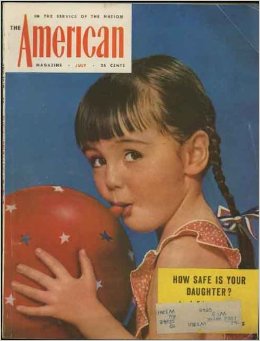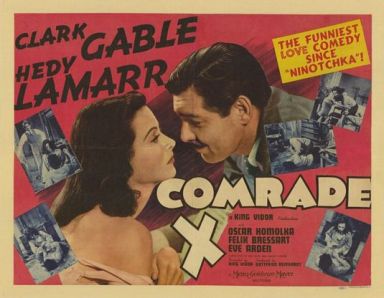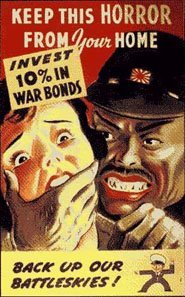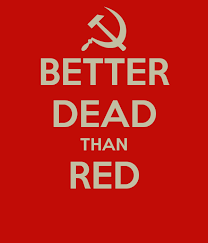Keep watching the Sky. Stay vigilant against another attack. – The War of the Worlds, 1953
Nineteenth century scholars saw hysteria in accounts of Dionysian cults rather than recognizing the god behind hysterical behavior.
In the 1930s, Life Magazine published articles such as “The Trojan Horse Policy of Communism in America” and “If the Communists Seized America.”

Hollywood helped demonize communists with Ninotchka, Comrade X and Red Salute; this continued into the Cold War (The Iron Curtain, The Red Menace) and beyond(Invasion U.S.A.). The only break was from 1942-1945, when the U.S. and the U.S.S.R. were hesitant partners against Germany. Then, Hollywood dutifully produced pro-Russian movies: Mission to Moscow and Song of Russia.
Forms change, but mythic narratives remain the same at their core. In 1938, when CBS Radio broadcast the original The War of the Worlds, millions panicked, believing that Martians had attacked the Earth. In truth, world war was approaching.
Once again the government required a new Other to overcome an entrenched sense of isolationism. And this required manipulating the old myth of the attack upon innocent Eden by a dark-skinned agent of evil. America fought a race war in the Pacific. Mendacious posters of ape-like “Japs” raping white women helped mobilize bellicosity and led to a savagery by U.S. soldiers against the Japanese that they rarely exhibited against the Germans.
From the perspective of the capitalist power structure, the major threat to stability was not Nazi Germany; it was the Soviet Union. Revisionist historians argue persuasively on three major points:
1 – Germany received massive financial aid from major segments of the American banking, oil and automotive industries (including Prescott Bush, father and grandfather of future presidents) before and during the war.
2 – The U.S. and Britain waited years to invade continental Europe, hoping that Germany and Russia would chew each other up on the Eastern front.
3 – Certain specific but horrific military actions, including the bombings of Dresden, Hiroshima and Nagasaki, had no military value. Hundreds of thousands of lives were sacrificed in primarily symbolic statements intended for the Soviets.
Indeed, it was the Nazis, capitalists at heart, who first used the slogan lieber tot als rot(“better dead than red”). Americans soon put it into common use as well. Again, we consider a hyperbolic statement (we recall Theodore Roosevelt claiming that rape by a black man was worse than murder) rooted in the Puritan terror of pollution.
Imagine: hating an ideology so much that one would prefer death. Is it possible that the implications of communist takeover and enforced sharing of resources (“…to each according to their needs”) actually call into question all of the other assumptions of “Americanism” – perpetual growth, pathological masculinity, purity of blood, the privileges of imperialism disguised as the redeemer nation?
America, essentially undamaged by the war, was now the world’s strongest nation. However, the fact remains that only military spending ended the depression. As in the 1890s, many argued that further economic expansion (investing surplus capital in foreign markets) would prevent unrest. This would require force and, for the first time, a permanent war economy. And this would mean re-invigorating the communist threat.
The corporate media’s range of acceptable discourse still frames the Cold War in terms of America’s heroic “containment of Soviet expansionism.” Containment: as in quarantining those who have been infected. Government documents, however, acknowledged that the primary threat was Europe’s “…refusal to subordinate their economies to…the West.”
Let’s take another detour through myth: the birth of the national security state coincided precisely with the peak popularity of western movies. Westerns had been central to the movies from the beginning. As late as 1959, westerns comprised one quarter of all prime-time network hours. Eleven of the top twenty-five shows were westerns. The Hero arrived just in time to dispose of the threat, just before the final commercial. Anxiety reversed, innocence restored.
“The purpose of propaganda,” writes psychologist Sam Keen, “is to paralyze thought, to prevent discrimination, and to condition individuals to act as a mass.” It is critical to understand how quickly – only months after Japan surrendered – our institutions (government, media, universities and churches) converted post-war optimism into hysteria, since this was certainly neither the first nor the last time this happened. In demonizing communists, they utilized the mythic narratives that fifteen generations of Americans had already consumed.
Mere months after Hiroshima, Life depicted rockets raining down from the east, predicting millions of dead. Advisors told President Truman in 1947 that in order to win approval for his foreign policy he would have to “scare hell out of the country.” His Attorney General warned: “They are everywhere – in factories, offices – and each carries with him the germs of death for society.” In 1950, FBI director J. Edgar Hoover declared that “Communists are today at work within the very gates of America.”
Propaganda films (do you remember “newsreels”?) portrayed Russia threatening Europe with its tentacles, or as a grapevine (the perfect image of Dionysus) spreading over the map. Week after week, they depicted a state of crisis, and with no opposition, reality was what appeared onscreen. Politicians brayed, “Like apples in a barrel infected by one rotten one, the corruption of Greece would infect Iran…” and, “…this red tide… like some vile creeping thing…spreading its web westward…” Note the language of pollution and infection.
Americanism now had a “higher power” (the state), dogma (anticommunism), zealots (the F.B.I.), modes of excommunication (the Hollywood blacklist) and clergy. Billy Graham, spiritual adviser to several American presidents, declared that communism was “a religion inspired…by the Devil himself.” Religion: what other word can describe the all-encompassing force that anticommunism injected into American life, how the fear, as well as the sense of identity, spread?
In this sense, 1950s Americanism can be called a negative ideology, of mere opposition to or fear of another way of thinking. Or we could call it a religion of denial, because it allowed nuclear bellicosity, neo-colonialism and de facto segregation to coincide with the ideals of freedom and opportunity. Millions resolved this immense contradiction by accepting the unrelenting propaganda; to be American was to be anticommunist. “If Americans could only band together against the common red foe,” writes Joel Kovel, “they would know who they were.”
Terror of the external Other was also bound up with an internal issue, gender anxiety, as it is now. The press attacked feminists as neurotic, sexually frigid – and communist. In 1948 the Kinsey Report revealed a huge gap between public morality and private behavior. Suddenly, deviants were inside the gates. Crusaders accused Truman’s administration of protecting a communist “homosexual underground.” Hoover asked, “How Safe Is Your Daughter?” In 1952, Eisenhower barred gays from federal jobs. Businesses and local governments forced workers to swear to their “moral purity.”
 Contagion and pollution are scientific terms, yet in our context, they have mythic potency. A half-century before the “Neo-Cons,” reactionaries were willing to say absolutely anything to amplify fear. From this point on, we can follow the predatory imagination to its logical extreme – doing whatever is necessary.
Contagion and pollution are scientific terms, yet in our context, they have mythic potency. A half-century before the “Neo-Cons,” reactionaries were willing to say absolutely anything to amplify fear. From this point on, we can follow the predatory imagination to its logical extreme – doing whatever is necessary.



